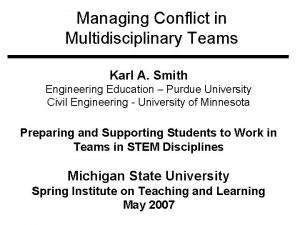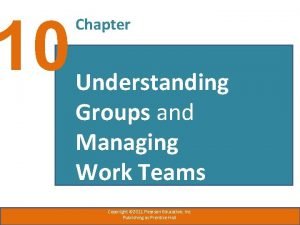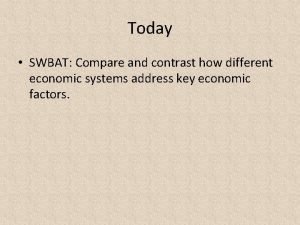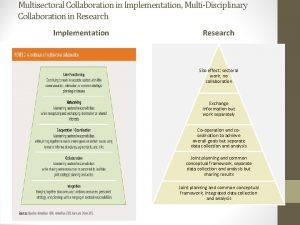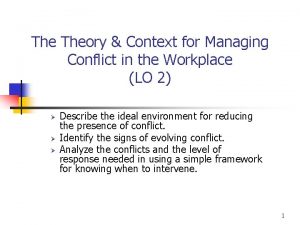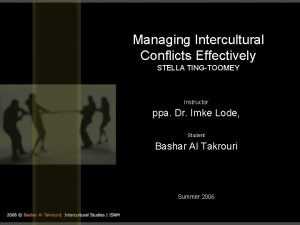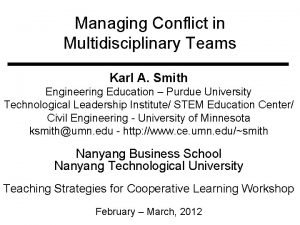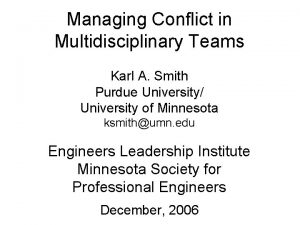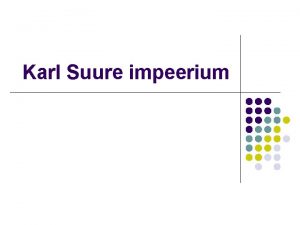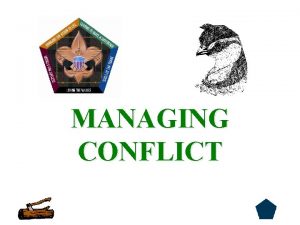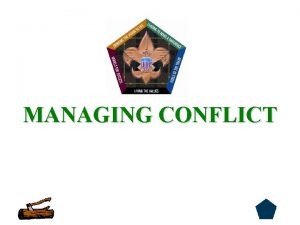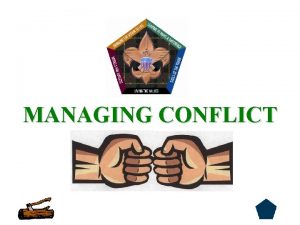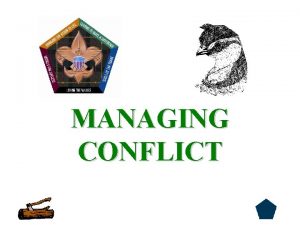Managing Conflict in Multidisciplinary Teams Karl A Smith


















- Slides: 18

Managing Conflict in Multidisciplinary Teams Karl A. Smith Engineering Education – Purdue University Civil Engineering - University of Minnesota Preparing and Supporting Students to Work in Teams in STEM Disciplines Michigan State University Spring Institute on Teaching and Learning May 2007

Conflict

Categorize and record the number of associations that fit in each of the following categories: Positive Negative Neutral Calculate the portion of associations that are positive (positive/(positive + negative + neutral)) 3

Types of Conflicts of Interest: Incompatible activities are based on needs differences, scarcities of resources, and competition for rewards. Controversy: One person’s ideas, information, conclusions, theories, and opinions are incompatible with those of another. Developmental Conflicts: Incompatible activities are based on the opposing forces of stability and change within a person. Conceptual Conflicts: Incompatible ideas exist simultaneously in a person’s mind.

CONFLICT OF INTEREST A conflict of interest exists when the actions of one person attempting to maximize his or her needs and benefits prevent, block, interfere with, injure, or in some way make less effective the actions of another person attempting to maximize his or her needs and benefits. Deutsch, M. 1973. The resolution of conflict. New Haven: Yale.

Blake & Mouton Conflict Model Importance of the Goal Importance of the Relationship

7

Conflict Strategies Withdrawing -Neither the goal nor the relationship are important -you withdraw from the interaction. Forcing -The task is important but not the relationship - use all your energy to get the task done. Smoothing -The relationship is more important than the task. You want to be liked and accepted. Compromising - Both task and relationship are important but there is a lack of time - you both gain and lose something. Confronting -Task and relationship are equally important. You define the conflict as a problem-solving situation and resolve through negotiation.

Which strategies do effective team members use? Ineffective team members? Under what conditions are each of these conflict strategies important? What words and phrases are needed to set up each strategy?

The work life of a project manager is a life of conflict. Although conflict is not necessarily bad, it is an issue that has to be resolved by the project manager. Without excellent negotiation skills, the project manager has little chance for success Taylor, J. 1998. A survival guide for project managers. AMACON.

Escalation of Conflicts – Strategies for Resolving Informal Negotiation Formal Negotiation Mediation Third-Party Mediation Arbitration Binding Arbitration Litigation 11

Confrontation and Negotiation A confrontation is the direct expression of one's view of the conflict and one's feelings about it while inviting the opposition to do the same. Suggested guidelines for confrontation are: 1. Do not "hit-and-run": confront only when there is time to jointly define the conflict and schedule a negotiating session. 2. Openly communicate one's feelings about and perceptions of the issues involved in the conflict, and try to do so in minimally threatening ways. 3. Accurately and fully comprehend opponent's views of the feelings about the conflict. A successful confrontation sets up an opportunity to negotiate.

Negotiating Guidelines Fisher & Ury - Getting to Yes Four Steps in Principled Negotiation 1. 2. 3. 4. Separate the people from the problem Focus on interests, not positions Create options, Insist on standards

Negotiation is a conflict resolution process by which people who want to come to an agreement, but disagree about the way to resolve, try to work out a settlement. Recommended steps in negotiating a conflict: 1. Confront the opposition. 2. Define the conflict mutually. 3. Communicate feelings and positions. 4. Communicate cooperative intentions. 5. Take the other person's perspective. 6. Coordinate the motivation to negotiate. 7. Reach an agreement that is satisfactory to both sides.

Heuristics for dealing with conflicts: 1. Do not withdraw from or ignore the conflict. 2. Do not engage in "win-lose" negotiations. 3. Assess for smoothing. 4. Compromise when time is short. 5. Confront to begin problem-solving negotiations. 6. Use your sense of humor.

Groupthink Groups without conflict where there is a strong norm of “Concurrence Seeking” Groupthink Video – CRM Films 16

Symptoms of Groupthink Overestimation of the Group Illusion of invulnerability Belief in group morality Closed Mindedness Rationalization Stereotyping Outgroups Pressures Toward Uniformity Self-censorship Direct pressure Mindguards Illusion of unanimity

Strategies for Avoiding Groupthink • Promote an open climate • Avoid the isolation of the team • Appoint critical evaluators • Avoid being too directive 18
 Conflict in multidisciplinary teams
Conflict in multidisciplinary teams Understanding groups and teams
Understanding groups and teams Compare and contrast, karl marx and adam smith venn diagram
Compare and contrast, karl marx and adam smith venn diagram Adam smith vs karl marx
Adam smith vs karl marx Kingsley davis
Kingsley davis Multidisciplinary vs interdisciplinary
Multidisciplinary vs interdisciplinary Multisectoral and multidisciplinary
Multisectoral and multidisciplinary Uksn almora
Uksn almora Interdisciplinary example
Interdisciplinary example Interdisciplinary multidisciplinary transdisciplinary
Interdisciplinary multidisciplinary transdisciplinary Multidisciplinary team pros and cons
Multidisciplinary team pros and cons Sundarlal bahuguna quotes
Sundarlal bahuguna quotes Epcc degree plans
Epcc degree plans Temasek laboratories
Temasek laboratories Multidisciplinary engineering definition
Multidisciplinary engineering definition Managing conflict theory
Managing conflict theory Managing conflict and negotiation
Managing conflict and negotiation Managing stress and conflict in the workplace
Managing stress and conflict in the workplace Stella ting toomey
Stella ting toomey
